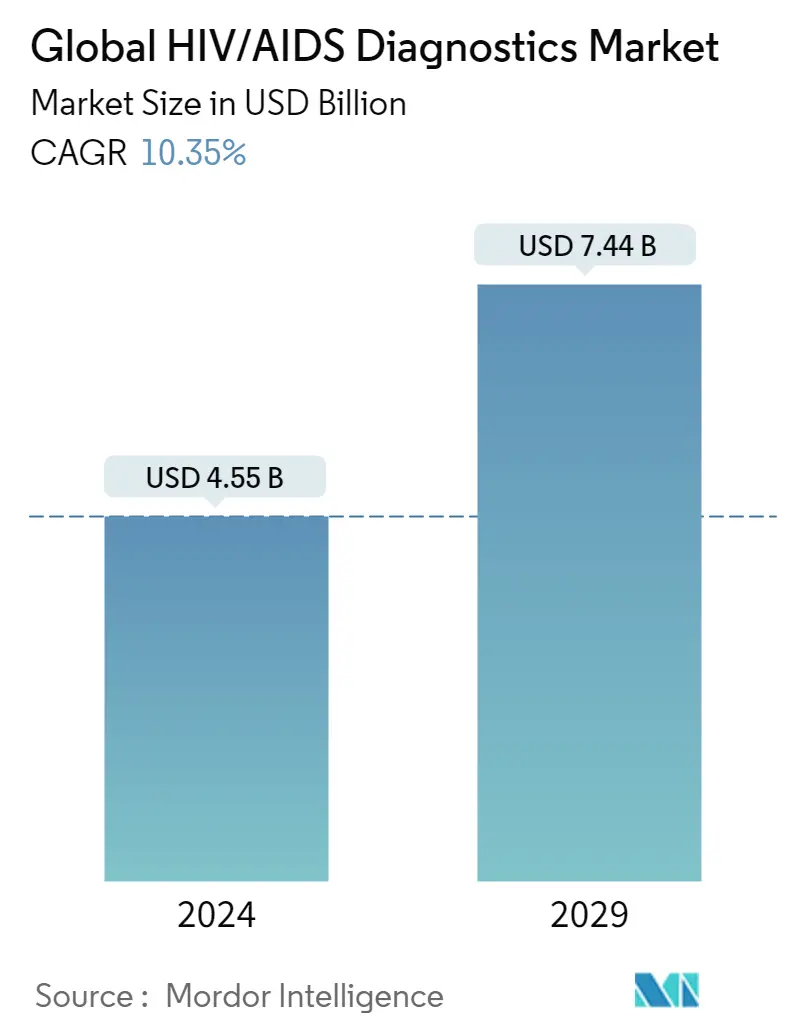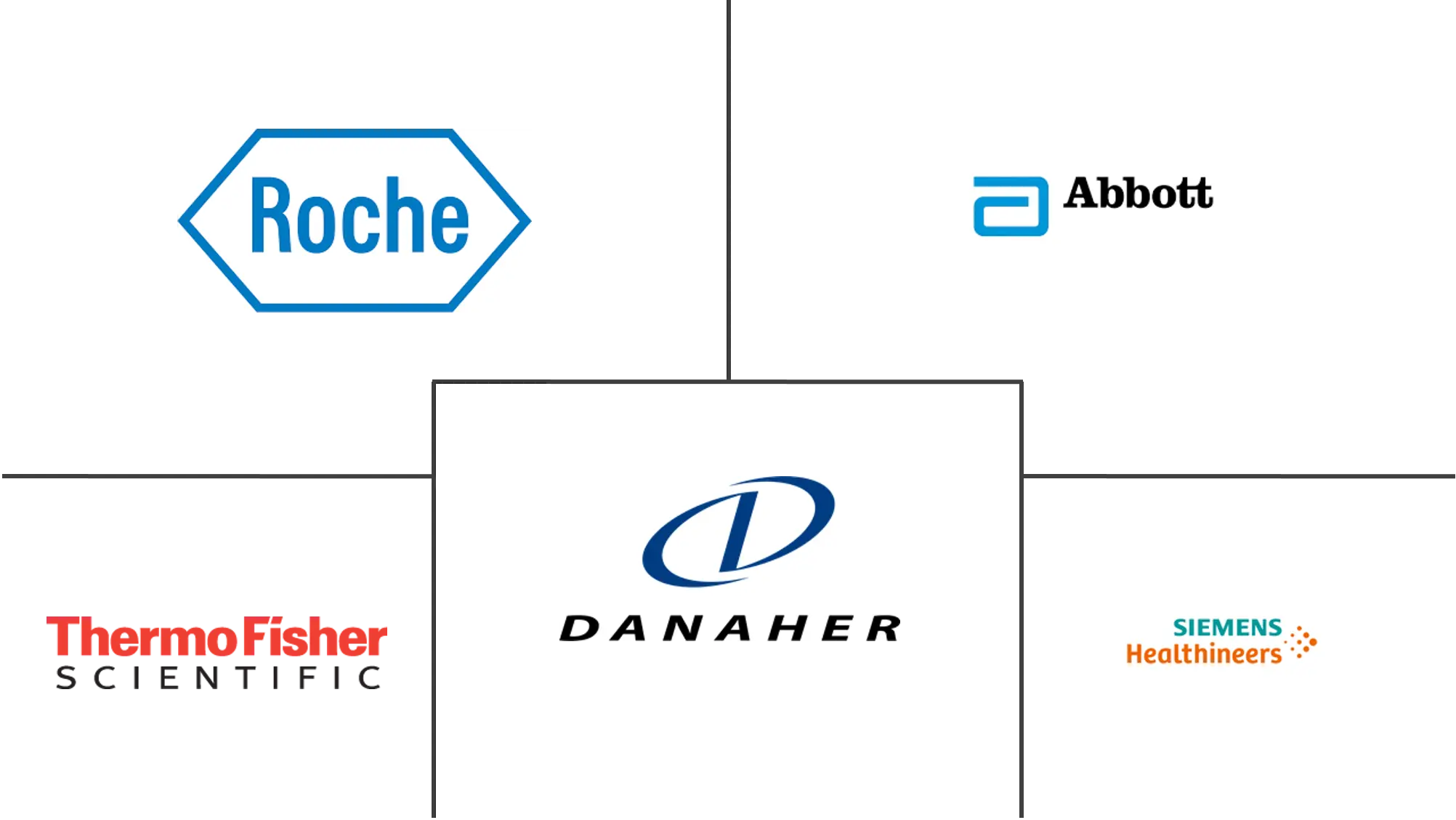
| Study Period | 2019 - 2029 |
| Market Size (2024) | USD 4.55 Billion |
| Market Size (2029) | USD 7.44 Billion |
| CAGR (2024 - 2029) | 10.35 % |
| Fastest Growing Market | Africa |
| Largest Market | North America |
| Market Concentration | Medium |
Major Players
*Disclaimer: Major Players sorted in no particular order |
HIV/AIDS Diagnostics Market Analysis
The Global HIV/AIDS Diagnostics Market size is estimated at USD 4.55 billion in 2024, and is expected to reach USD 7.44 billion by 2029, growing at a CAGR of 10.35% during the forecast period (2024-2029).
COVID-19 caused a dramatic decline in HIV testing and, as a consequence, a much lower number of new HIV diagnoses. In May 2022, an article published titled "COVID Caused Drop-in HIV Testing, Diagnoses" stated that the Centers for Disease Control and Prevention (CDC) 2020 HIV surveillance report showed COVID disruptions. The COVID-19 pandemic in the United States led to disruptions in HIV testing services and access to clinical services throughout 2020. This disruption resulted in a steep, single-year decline in HIV diagnoses that is mostly attributed to declines in testing caused by less frequent visits to health centers, reduced outreach services, and shifting of public health staff to COVID-19 response activities. Similarly, in December 2021, a report published by the Government of Canada, titled "HIV in Canada: 2020 Surveillance highlights" stated that the COVID-19 pandemic resulted in a decreased demand for, and ability to provide, services related to sexually transmitted and bloodborne infections, including HIV testing. This may have had an impact on observed new diagnosis rates for HIV in 2020. Hence, the COVID-19 pandemic has a negative impact on market growth. However, in the future, the market is likely to grow.
Factors such as the increasing prevalence of HIV along with new initiatives and product launches are the primary reasons for the growth of the market. According to the World Health Organization (WHO) update in November 2021, HIV continues to be a major global public health issue, having claimed 36.3 million lives so far. There were an estimated 37.7 million (30.2-45.1 million) people living with HIV at the end of 2020, over two-thirds of whom (25.4 million) are in the WHO African Region. In 2020, 680,000 (480,000-1.0 million) people died from HIV-related causes and 1.5 million (1.0-2.0 million) people acquired HIV.
The increasing initiatives by public organizations such as United Nations Programme on HIV and AIDS. (UNAIDS) provides awareness and investments to the market. To reach the new proposed global 95-95-95 targets set by UNAIDS, to avoid the worst-case scenario of 7.7 million HIV-related deaths over the next 10 years, increasing HIV infections due to HIV service disruptions during COVID-19, and the slowing public health response to HIV. Such initiatives increase awareness which increases the demand for more diagnostic tests which increases the growth of the market.
Furthermore, the new research and developments, technological innovations, and the launch of technologically advanced products by key players are expected to boost the growth of the market. For instance, in April 2021, Altona Diagnostics launched an in-vitro diagnostic test based on real-time RT-PCR technology that detects and quantifies the human immunodeficiency virus (HIV) specific RNA in human plasma. The test was named as AltoStar HIV RT-PCR Kit 1.5. Therefore, due to the above-stated factors, the studied market is anticipated to witness notable growth during the study period.
However, the lack of mandates for nucleic acid tests in developing countries is likely to hinder market growth.
HIV/AIDS Diagnostics Industry Segmentation
As per the scope of the report HIV/AIDS diagnostics are used to investigate the existence of the human immune-deficiency virus, in saliva, serum or urine. HIV/AIDS diagnostics helps to detect antibodies, RNA or antigens. Blood tests are the most regular way to make a diagnosis of HIV. HIV is most commonly diagnosed by doing a urine test and blood test. The HIV/AIDS Diagnostics Market is Segment by Product (Consumables, Instruments, and Software & Services), Test Type (Antibody Tests, Viral Load Tests, CD4 Tests, and Others), End User (Diagnostic Laboratories, Hospitals, and Others), and Geography (North America, Europe, Asia-Pacific, Middle East and Africa, and South America). The market report also covers the estimated market sizes and trends for 17 different countries across major regions, globally. The report offers the value (in USD million) for the above segments.
| Consumables |
| Instruments |
| Software & Services |
| Antibody Tests |
| Viral Load Tests |
| CD4 Tests |
| Others |
| Diagnostic Laboratories |
| Hospitals |
| Others |
| North America | United States |
| Canada | |
| Mexico | |
| Europe | Germany |
| United Kingdom | |
| France | |
| Italy | |
| Spain | |
| Rest of Europe | |
| Asia-Pacific | China |
| Japan | |
| India | |
| Australia | |
| South Korea | |
| Rest of Asia-Pacific | |
| Middle-East and Africa | GCC |
| South Africa | |
| Rest of Middle-East and Africa | |
| South America | Brazil |
| Argentina | |
| Rest of South America |
Global HIV/AIDS Diagnostics Market Size Summary
The HIV diagnosis and treatment market is poised for significant growth over the forecast period, driven by the increasing prevalence of HIV globally and the ongoing efforts to enhance diagnostic capabilities. The market's expansion is supported by new initiatives and product launches, as well as technological advancements in diagnostic tools. Despite the setbacks caused by the COVID-19 pandemic, which disrupted testing services and led to a decline in new diagnoses, the market is expected to recover and grow. Public health organizations, such as UNAIDS, are playing a crucial role in raising awareness and providing investments to meet global health targets, thereby boosting demand for HIV diagnostics. The introduction of innovative products, like the AltoStar HIV RT-PCR Kit, further underscores the market's potential for growth.
North America is anticipated to lead the market due to its established healthcare infrastructure, high prevalence of HIV/AIDS, and the presence of key industry players. The region's market growth is further supported by government initiatives and funding aimed at combating HIV. In addition to North America, other regions are witnessing increased investments and strategic programs to enhance diagnostic capabilities. The market is moderately competitive, with major players like Siemens Healthineers and Roche actively contributing to its development. Collaborative efforts, such as those by Roche and The Global Fund, aim to address infrastructure challenges in HIV diagnostics, highlighting the global commitment to improving healthcare outcomes. These factors collectively indicate a promising growth trajectory for the HIV diagnosis and treatment market.
Global HIV/AIDS Diagnostics Market Size - Table of Contents
1. MARKET DYNAMICS
- 1.1 Market Overview
-
1.2 Market Drivers
- 1.2.1 Growing Prevalence of HIV/Aids globally
- 1.2.2 Increasing Government Initiatives
-
1.3 Market Restraints
- 1.3.1 Lack of Mandates for Nucliec acid test in Developing Countries
-
1.4 Porter's Five Forces Analysis
- 1.4.1 Threat of New Entrants
- 1.4.2 Bargaining Power of Buyers/Consumers
- 1.4.3 Bargaining Power of Suppliers
- 1.4.4 Threat of Substitute Products
- 1.4.5 Intensity of Competitive Rivalry
2. MARKET SEGMENTATION (Market Size by Value - USD million)
-
2.1 By Product
- 2.1.1 Consumables
- 2.1.2 Instruments
- 2.1.3 Software & Services
-
2.2 By Test Type
- 2.2.1 Antibody Tests
- 2.2.2 Viral Load Tests
- 2.2.3 CD4 Tests
- 2.2.4 Others
-
2.3 By End User
- 2.3.1 Diagnostic Laboratories
- 2.3.2 Hospitals
- 2.3.3 Others
-
2.4 Geography
- 2.4.1 North America
- 2.4.1.1 United States
- 2.4.1.2 Canada
- 2.4.1.3 Mexico
- 2.4.2 Europe
- 2.4.2.1 Germany
- 2.4.2.2 United Kingdom
- 2.4.2.3 France
- 2.4.2.4 Italy
- 2.4.2.5 Spain
- 2.4.2.6 Rest of Europe
- 2.4.3 Asia-Pacific
- 2.4.3.1 China
- 2.4.3.2 Japan
- 2.4.3.3 India
- 2.4.3.4 Australia
- 2.4.3.5 South Korea
- 2.4.3.6 Rest of Asia-Pacific
- 2.4.4 Middle-East and Africa
- 2.4.4.1 GCC
- 2.4.4.2 South Africa
- 2.4.4.3 Rest of Middle-East and Africa
- 2.4.5 South America
- 2.4.5.1 Brazil
- 2.4.5.2 Argentina
- 2.4.5.3 Rest of South America
HIV/AIDS Diagnostics Market Research FAQs
How big is the Global HIV/AIDS Diagnostics Market?
The Global HIV/AIDS Diagnostics Market size is expected to reach USD 5.02 billion in 2025 and grow at a CAGR of 10.35% to reach USD 8.22 billion by 2030.
What is the current Global HIV/AIDS Diagnostics Market size?
In 2025, the Global HIV/AIDS Diagnostics Market size is expected to reach USD 5.02 billion.


